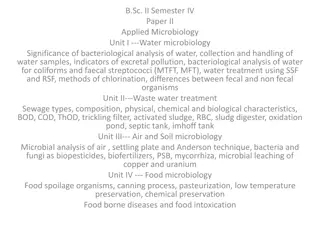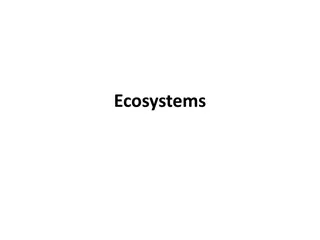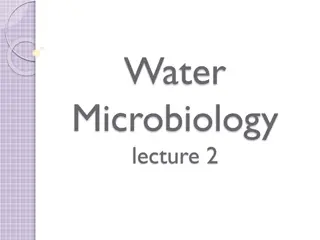Understanding the Scope and Importance of Soil Microbiology in Ecosystems
Soil microbiology plays a significant role in supporting plant communities and maintaining soil health. Living organisms, both plant and animal types, form only a small fraction of soil mass but are crucial for processes like plant growth, organic matter decomposition, humus formation, and biogeochemical cycling. Soil microbes also act as bio-control agents, aid in seed germination, biological N2 fixation, and the degradation of pesticides. The soil is a living system inhabited by diverse organisms that contribute to soil structure, nutrient availability, and overall ecosystem balance.
- Soil microbiology
- Ecosystem health
- Plant growth support
- Organic matter decomposition
- Bio-control agents
Download Presentation

Please find below an Image/Link to download the presentation.
The content on the website is provided AS IS for your information and personal use only. It may not be sold, licensed, or shared on other websites without obtaining consent from the author. Download presentation by click this link. If you encounter any issues during the download, it is possible that the publisher has removed the file from their server.
E N D
Presentation Transcript
Scope and Importance of Soil Microbiology Living organisms both plant and animal types constitute an important component of soil. Though these organisms form only a fraction (less than one percent) of the total soil mass, but they play important role in supporting plant communities on the earth surface. While studying the scope and importance of soil microbiology, soil-plant-animal ecosystem as such must be taken into account. Therefore, the scope and importance of soil microbiology, can be understood in better way by studying aspects like.
1. Soil as a living system. 2. Soil microbes and plant growth. 3. Soil microorganisms and soil structure. 4. Organic matter decomposition. 5. Humus formation. 6. Biogeochemical cycling of elements. 7.Soil microorganisms as bio-control agents. 8. Soil microbes and seed germination, 9. Biological N2 fixation, 10. Degradation of pesticides in soil.
1- Soil as a living system Soil inhabit diverse group of living organisms, both micro flora (fungi, bacteria, algae and actinomycetes) and micro- fauna (protozoa, nematodes, earthworms, moles, ants). The density of living organisms in soil is very high i.e. as much as billions / gm. of soil, usually density of organisms is less in uncultivated soil / virgin land than cultivated and population decreases with soil acidity. Top soil, the surface layer contains greater number of microorganisms because it is well supplied with Oxygen and nutrients. Lower layer / subsoil is depleted with Oxygen and nutrients hence it contains fewer organisms. Soil ecosystem comprises of organisms which are both, autotrophs (Algae, BOA) and heterotrophs (fungi, bacteria).Autotrophs use inorganic carbon from CO2 and are "primary producers" of organic matter, whereas heterotrophs use organic carbon and are decomposers/consumers.
2- Soil microbes and plant growth: Microorganisms being minute and microscopic, they are universally present in soil, water and air. Besides supporting the growth of various biological systems, soil and soil microbes serve as a best medium for plant growth. Soil fauna & flora convert complex organic nutrients into simpler inorganic forms which are readily absorbed by the plant for growth. Further, they produce variety of substances like IAA(Indole acetic acid) physiologically active auxins, gibberellins ,antibiotics etc. which directly or indirectly promote the plant growth
3. Soil microbes and soil structure: Soil structure is dependent on stable aggregates of soil particles-Soil organisms play important role in soil aggregation. Constituents of soil are viz. organic matter, polysaccharides, lignins and gums, synthesized by soil microbes plays important role in cementing / binding of soil particles. Further, cells and mycelia strands of fungi and actinomycetes, Vormicasts from earthworm is also found to play important role in soil aggregation. Different soil microorganisms, having soil aggregation / soil binding properties are graded in the order as fungi > actinomycetes > gum producing bacteria > yeasts. Examples are: Fungi like Rhizopus, Mucor, Chaetomium, Fusarium, Cladosporium, Rhizoctonia, Aspergillus, Trichoderma like Azotobacter, Rhizobium ,Bacillus and Xanthomonas. and Bacteria
4. Soil microbes and organic matter decomposition: The organic matter serves not only as a source of food for microorganisms but also supplies energy for the vital processes of metabolism that are characteristics of living beings. Microorganisms such actinomycetes, bacteria, protozoa etc. and macro organisms such as earthworms, termites, insects etc. plays important role in the process of decomposition of organic matter and release of plant nutrients in soil. Thus, organic matter added to the soil is converted by oxidative decomposition to simpler nutrients /substances for plant growth and the residue is transformed into humus. Organic matter /substances include cellulose, lignins and proteins (in cell wall of plants), glycogen (animal tissues), proteins and fats (plants, animals). Cellulose is degraded by bacteria, especially as fungi,
those genera(Bacillus, and Vibrio Achromobacter) and fungal genera (Aspergillus, Penicilliun, Chactomium,Curvularia). Lignins and proteins are partially digested by fungi, protozoa and nematodes. Proteins are degraded to individual amino acids mainly by fungi, actinomycetes and Clostridium. of genus Cytophaga Pseudomonas, and Cellulomonas, other Trichoderma, Under unaerobic conditions of waterlogged soils, methane are main carboncontaining product which is produced by the bacterial genera (strict anaerobes) Methanococcus, Methanobacterium and Methanosardna.
5. Soil microbes and humus formation: Humus is the organic residue in the soil resulting from decomposition of plant and animal residues in soil, or it is the highly complex organic residual matter in soil which is not readily degraded by microorganism, or it is the soft brown/dark coloured amorphous substance composed of residual organic matter along with dead microorganisms.
6. Soil microbes and cycling of elements: Life on earth is dependent on cycling of elements from their organic / elemental state to inorganic compounds, then to organic compounds and back to their elemental states. The biogeochemical process through which organic compounds are broken down to inorganic compounds or their constituent elements is known Mineralization , or microbial conversion of complex organic compounds into simple inorganic compounds & their constituent elements is known as mineralization .Soil microbes plays important role in the biochemical cycling of elements in the biosphere where the essential elements (C, P, S, N & Iron etc.) undergo chemical transformations. Through the process of mineralization organic carbon, nitrogen, phosphorus, Sulphur, Iron etc. are made available for reuse by plants.
7. Soil microbes and biological N2 fixation: Conversion of atmospheric nitrogen in to ammonia and nitrate by microorganisms is known as biological nitrogen fixation. Fixation of atmospheric nitrogen is essential because of the reasons: 1.Fixed nitrogen is lost through the process of nitrogen cycle through denitrification. 2.Demand for fixed nitrogen by the biosphere always exceeds its availability. 3.The amount of nitrogen fixed chemically and lightning process is very less (i.e. 0.5%) as compared to biologically fixed nitrogen. 4. Nitrogenous fertilizers contribute only 25% of the total world requirement while biological nitrogen fixation contributes about 60% of the earth's fixed nitrogen. 5.Manufacture of nitrogenous fertilizers by "Haber" process is costly and time consuming.
The numbers of soil microorganisms carry out the process of biological nitrogen fixation at normal atmospheric pressure (1 atmosphere) and temp (around 20 C).Two groups of microorganisms are involved in the process of BNF.A. Non-symbiotic (free living) and B. Symbiotic (Associative) Non-symbiotic (free living): Depending upon the presence or absence of oxygen, non symbiotic N2 fixation prokaryotic organisms may (Azotobacter, Pseudomonas, autotrophs (Nostoc, Anabena, Calothrix, BGA(blue green algae)) and anaerobic heterotrophs (Clostridium, Kelbsiella. Desulfovibrio) or (Chlorobium,Chromnatium, Methanobacterium etc) Symbiotic (Associative): The organisms involved are Rhizobium, Bratfyrhizobium legumes(aerobic): Azospirillum (grasses), Actinonycetes frantic(with Casuarinas, Alder). be Achromobacter) or aerobic aerobic heterotrophs anaerobic Autotrophs Rhodospirillum, in
8. Soil microbes as biocontrol agents: Several ecofriendly bioformulations of microbial originate used in agriculture for the effective management of plant diseases, insect pests, weeds etc. eg: Trichoderma sp and Gleocladium sp are used for biological control of seed bornediseases. Fungal genera Beauveria, Metarrhizium protozoa Maltesia grandis. Malameba locustiae etc are used in the management of insect pests. Nuclear polyhydrosis virus (NPV) is used for the control of Heliothis / American boll worm. Bacteria like Bacillus thuringiensis, Pseudomonas are used in cotton against Angular leaf spot and bollworms. and soil Entomophthora, and
9 . Degradation of pesticides in soil by microorganisms: Soil receives different toxic chemicalsin various forms and causes adverse effects on beneficial soil micro flora / micro fauna, plants, animals and human beings. Various microbes present in soil act as the scavengers of these harmful chemicals in soil. The pesticides/chemicals reaching the soil are acted upon by several physical, chemical and biological forces exerted by microbes in the soil and they are degraded into non-toxic substances and thereby minimize the damage caused by the pesticides to the ecosystem. For example, bacterial genera like Pseudomonas, Clostridium, Bacillus, Thiobacillus, Achromobacter etc. and likeTrichoderma, Penicillium, and Fusarium are playing important role in the degradation of the toxic chemicals / pesticides in soil. fungal genera Aspergillus, Rhizopus,
10. Biodegradation of hydrocarbons: Natural paraffin s, oils etc are degraded by fungi, bacteria and actinomycetes. E.g. ethane (C2H6) a paraffin hydrocarbon is metabolized and degraded by Mycobacteria, Streptomyces ,Pseudomonas, Flavobacterium and several fungi. hydrocarbons in soil like waxes, Nocardia























